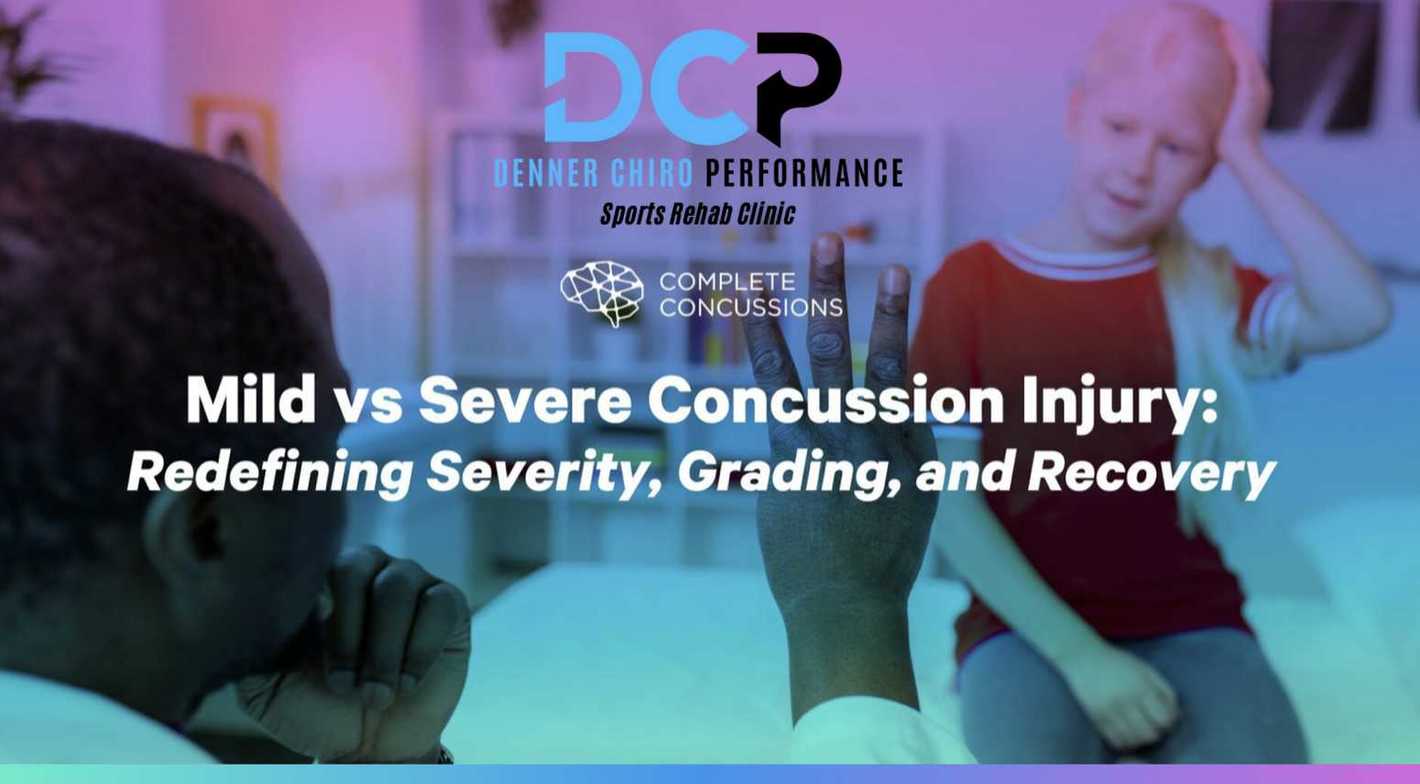
Severe vs Mild Concussion Injury: Concussion Grading, Severity, and Recovery | Charlotte Concussion Clinic
Experiencing a concussion can be a complex journey, marked by a variety of symptoms and uncertainties. From mild headaches to more pronounced issues like visual disturbances, neck pain, and cognitive fogginess, each person’s experience with a concussion is unique.
Post-concussion, the inevitable question arises: “How severe is my concussion?” It’s a common question directed at healthcare professionals as patients seek to understand their recovery trajectory.
Given that many injuries are traditionally graded on a scale, with outcomes and recovery time correlating with severity, it’s understandable that individuals may assume a similar structure for concussions. However, current research suggests otherwise.
In this latest discussion, we will explore the research and current understanding of the idea of grading concussion injuries and provide you with an answer to a common question such as “Is there such a thing as a mild concussion?” “Is there a standardized grading scale for concussion injuries?” and “What do the current guidelines and evidence show?”
Understanding Concussion Injuries
Concussion injuries were once believed to be caused by a coup-contrecoup injury, where the brain would hit the skull and cause bruising to the outside of the brain, resulting in inflammation, memory loss, brain swelling, and presentation of concussion symptoms.
Common concussion signs and symptoms may include:
- blurry vision
- balance problems
- double vision
- impaired mental function
- memory loss
- mood swings
In the past decade, research has been conducted to provide a new and more accurate understanding of what occurs during a concussion injury. Our current understanding is that a concussion results from the rapid acceleration-deceleration of the brain within the skull.
This rapid movement causes the stretching of neurons, inducing a physiological cascade of events leading to a chemical imbalance and energy deficit within the brain. This energy deficit only lasts for a brief period. Soon after the initial impact energy levels will gradually replenish, and the chemical balance is quickly normalized, leading to full metabolic recovery around 22-30 days. (1)
The symptoms that persist longer than the metabolic period are due to functional changes that occur in our bodies, such as how our neck, visual/vestibular system, and nervous system communicate with our brain. Symptoms should be viewed not as a result of structural damage to the brain but rather as a reflection of how the brain actively perceives and interprets input from the surrounding environment.
Head/Brain Injuries
Let’s explore the medical grading scale for head injuries together. Understanding the different categories of head trauma can provide us with valuable insights into what exactly constitutes a concussion.
OUTDATED APPROACH
In the past, healthcare professionals used a grading scale to diagnose concussions. Upon diagnosis of serious injury, healthcare providers would assess the injury based on specific severity indicators (2), including the type of impact, the severity of initial symptoms, and the presence of loss of consciousness. Healthcare providers would then classify the injury as Grade 1, Grade 2, or Grade 3 based on the indicators.
However, this approach has become outdated. The shift away from this grading system occurred because clinical outcomes and recovery time proved to be inconsistent with the assigned grades. In numerous instances, patients diagnosed with a “Grade 3” concussion recovered quicker than those labeled with a “Grade 1” head injury, rendering the entire grading system irrelevant.
CURRENT APPROACH
As our comprehension of diagnosing concussion injuries evolved, it became clear that the criteria for mild traumatic brain injury and concussion were the same.
Consequently, a decision was made to merge these categories. In today’s literature, you’ll frequently encounter these terms used interchangeably.
Is There Such a Thing as a Mild or Severe Concussion?
Based on the information discussed above, the answer to our question is…. no. The current evidence does not support the idea that a concussion can be classified as mild or severe.
Concussion or mild traumatic brain injuries follow the all-or-none principle—either you’ve experienced enough force to trigger a concussion, or you haven’t.
This concept aligns with findings in recent literature, demonstrating that despite variations in factors like loss of consciousness or symptom presentation, the body consistently undergoes a specific physiological healing response after a concussion.
This highlights the challenge healthcare professionals face when assigning a 1-3 scale to concussions, as predicting recovery time and understanding individual experiences becomes intricate and unique to the individual case.
Decoupling Symptoms from Recovery Trajectory
Relying solely on your post-concussion symptoms might not provide a comprehensive understanding of your recovery trajectory. This is because each patient will perceive and interact with the world uniquely, using various mechanisms like blood flow regulation, neck coordination, eye tracking, and vestibular function.
When one or a combination of these systems gets disrupted following a concussion, it can lead to a wide range of reported symptoms.
Additionally, lifestyle factors, physical activity, existing health conditions, and an individual’s mindset play a significant role in how they recover from a concussion injury.
These factors contribute to each concussion patient having a distinct experience with symptoms, creating variations even when their initial injuries seem extremely similar.
Conclusion
After a concussion, the common question emerges: “How severe is my concussion?” It’s a question we often ask healthcare professionals as we seek to understand our recovery journey.
While traditional grading scales may seem familiar, current research challenges their relevance to concussions.
Contrary to prior beliefs, concussions aren’t neatly categorized as mild or severe head injuries. The all-or-none principle dictates that either you’ve experienced enough force to trigger a concussion or you haven’t.
In current concussion protocol, healthcare providers use a standardized classification regardless of symptom severity.
Given that symptoms post-concussion vary and may not always indicate structural brain damage, relying solely on them for assessment reveals its limitations. Recognizing the intricate interplay of blood flow, neck function, eye tracking, and vestibular function in shaping post-concussion experiences highlights the importance of factoring in personal elements when determining an individual’s response and recovery.
This contemporary understanding reveals the significance of treating concussions based on individual characteristics rather than conforming to a predefined scale. The protocol acknowledges the necessity of customizing care to each person’s unique response.
CITATIONS
- Vagnozzi R, Signoretti S, Cristofori L, et al. Assessment of metabolic brain damage and recovery following mild traumatic brain injury: a multicentre, proton magnetic resonance spectroscopic study in concussed patients [published correction appears in Brain. 2013 Nov;136(Pt 11):i1. Marziale, Simone [corrected to Marziali, Simone]]. Brain. 2010;133(11):3232-3242
- Williams, V. B., & Danan, I. J. (2016). A historical perspective on sports concussion: where we have been and where we are going. Current pain and headache reports, 20, 1-8.
Denner Chiropractic & Performance | Charlotte, North Carolina
At Denner Chiropractic & Performance located in Charlotte, North Carolina our rehab chiropractic care incorporates rehabilitation, joint manipulation, soft tissue, and dry needling to help you achieve pain-free movement in life and sport. We are more than happy to discuss any concerns or questions you have about your condition or how we can help. Denner Chiropractic & Performance is the only CCMI-certified concussion clinic in the Carolinas.

Denner Chiro Performance
Contact Me



